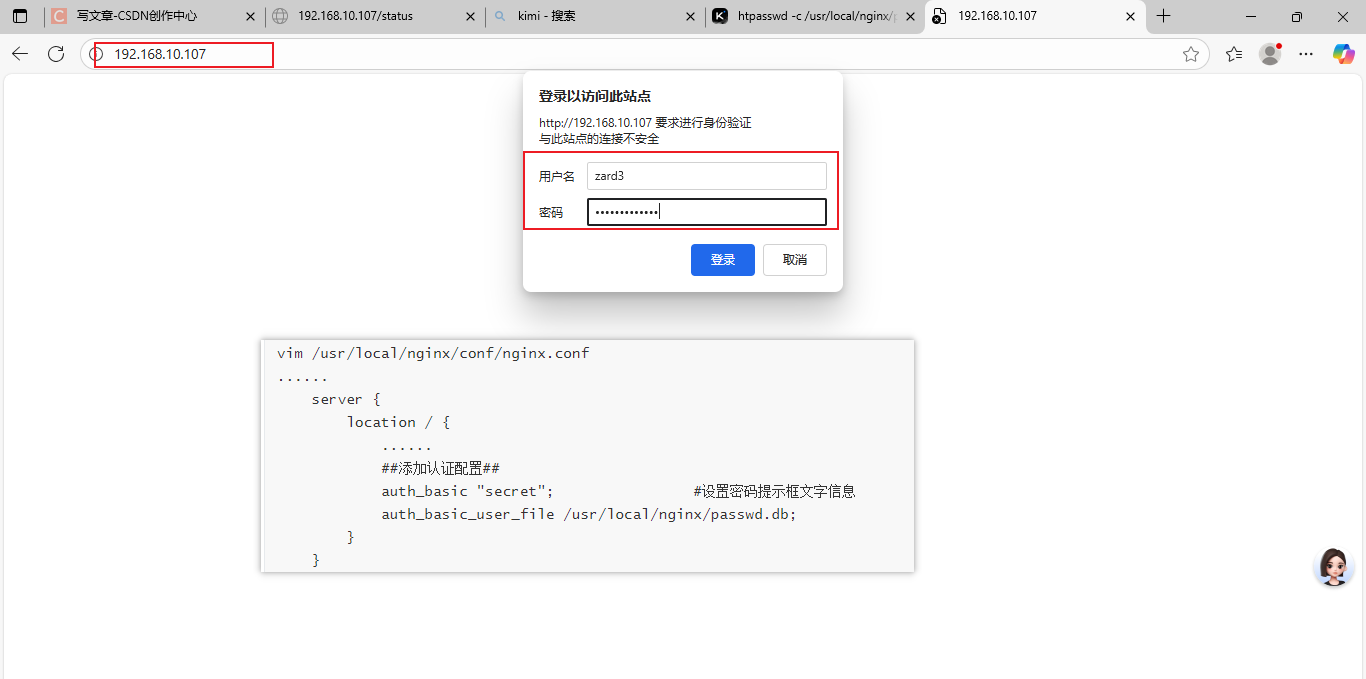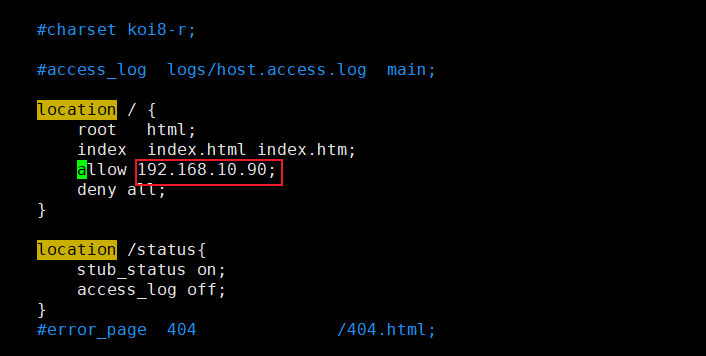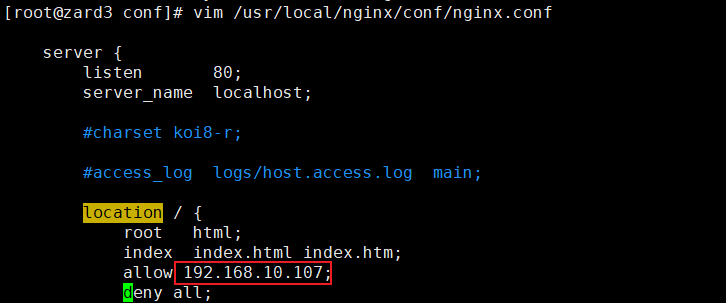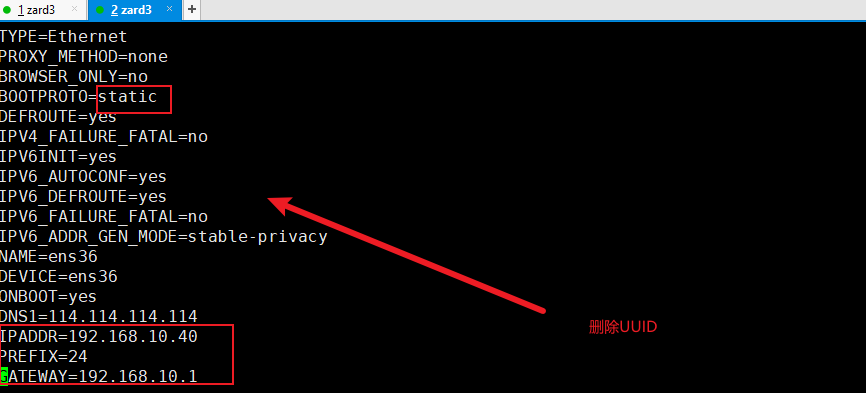本文基于 Nginx 实际部署经验,系统梳理了 Nginx 的核心配置结构、虚拟主机配置方式(基于域名、IP、端口),并附带了访问控制与状态统计模块的使用方法,适合初学者和运维人员快速上手。
目录
前言
Nginx 早已不只是“反向代理”的代名词,更是高并发架构的守门人。面对日嚣的访问压力与多元业务需求,唯有吃透其三大虚拟主机模式、四层访问控制及状态统计机制,方能在有限资源内榨干每一分性能。本文以实战为导向,从升级平滑热替、域名-IP-端口三维隔离,到鉴权、IP 白名单与 stub_status 监控,逐行拆解配置细节,带你把单台服务器玩出集群级灵活度;更结合真实报错与日志分析,给出可复制、可落地的调优模板,助你在分钟级完成站点扩容与安全防护,让 Nginx 真正成为业务增长的“加速引擎”。
一、Nginx 配置文件结构概览
Nginx 的主配置文件通常位于:
/usr/local/nginx/conf/nginx.conf配置文件主要分为以下几个模块:
1. 全局配置(main 块)
#user nobody; # 运行用户,默认 nobody
worker_processes 4; # 工作进程数,建议设置为 CPU 核心数
#error_log logs/error.log; # 错误日志路径
#pid logs/nginx.pid; # PID 文件路径2. I/O 事件配置(events 块)
events {
use epoll; # 使用 epoll 模型,提升高并发性能
worker_connections 4096; # 每个进程最大连接数
}提示:如需支持更高并发,可执行
ulimit -n 65535提高系统文件句柄限制。
二、HTTP 配置模块详解(http 块)
http 块是配置 Web 服务的核心区域,包含日志格式、文件类型、连接保持、gzip 压缩等设置。
http {
include mime.types;
default_type application/octet-stream;
sendfile on;
keepalive_timeout 65;
#gzip on;
}三、Server 块:Web 服务监听配置
每个 server 块代表一个虚拟主机,可监听不同域名、IP 或端口。
server {
listen 80;
server_name www.kgc.com;
charset utf-8;
location / {
root html;
index index.html index.php;
}
error_page 500 502 503 504 /50x.html;
location = /50x.html {
root html;
}
}修改配置文件
修改 nginx.conf 配置文件,指定访问位置并添加 stub_status 配置
cd /usr/local/nginx/conf
cp nginx.conf nginx.conf.bak
vim /usr/local/nginx/conf/nginx.conf
......
http {
......
server {
listen 80;
server_name www.benet.com;
charset utf-8;
location / {
root html;
index index.html index.php;
}
##添加 stub_status 配置##
location /status { #访问位置为/status
stub_status on; #打开状态统计功能
access_log off; #关闭此位置的日志记录
}
}
}图片
 基于授权的访问控制
基于授权的访问控制
生成用户密码认证文件
yum install -y httpd-tools
htpasswd -c /usr/local/nginx/passwd.db zhangsan
chown nginx /usr/local/nginx/passwd.db
chmod 400 /usr/local/nginx/passwd.db修改主配置文件相对应目录,添加认证配置
vim /usr/local/nginx/conf/nginx.conf
......
server {
location / {
......
##添加认证配置##
auth_basic "secret"; #设置密码提示框文字信息
auth_basic_user_file /usr/local/nginx/passwd.db;
}
}网络连接

基于客户端的访问控制
本机地址为192.168.10.90
但是我将allow换成192.168.10.90时

然后就被允许了

修改nginx配置文件
为虚拟主机准备网页
[root@zard3 conf]# mkdir -p /usr/local/nginx/html/zard3
[root@zard3 conf]# mkdir -p /usr/local/nginx/html/yjs
[root@zard3 conf]# echo "<h1>www.yjs.com</h1>" >/usr/local/nginx/html/yjs/index.html
[root@zard3 conf]# echo "<h1>www.zard3.com</h1>" >/usr/local/nginx/html/zard3/index.html
修改配置文件
#user nobody;
worker_processes 1;
#error_log logs/error.log;
#error_log logs/error.log notice;
#error_log logs/error.log info;
#pid logs/nginx.pid;
events {
worker_connections 1024;
}
http {
include mime.types;
default_type application/octet-stream;
#log_format main '$remote_addr - $remote_user [$time_local] "$request" '
# '$status $body_bytes_sent "$http_referer" '
# '"$http_user_agent" "$http_x_forwarded_for"';
#access_log logs/access.log main;
sendfile on;
#tcp_nopush on;
#keepalive_timeout 0;
keepalive_timeout 65;
#gzip on;
server {
listen 80;
server_name www.yjs.com;
charset utf-8;
access_log logs/www.yjs.access.log;
location / {
root /usr/local/nginx/html/yjs;
index index.html index.htm;
}
#error_page 404 /404.html;
# redirect server error pages to the static page /50x.html
#
error_page 500 502 503 504 /50x.html;
location = /50x.html {
root html;
}
# proxy the PHP scripts to Apache listening on 127.0.0.1:80
#
#location ~ \.php$ {
# proxy_pass http://127.0.0.1;
#}
# pass the PHP scripts to FastCGI server listening on 127.0.0.1:9000
#
#location ~ \.php$ {
# root html;
# fastcgi_pass 127.0.0.1:9000;
# fastcgi_index index.php;
# fastcgi_param SCRIPT_FILENAME /scripts$fastcgi_script_name;
# include fastcgi_params;
#}
# deny access to .htaccess files, if Apache's document root
# concurs with nginx's one
#
#location ~ /\.ht {
# deny all;
#}
}
server {
listen 80;
server_name www.zard3.com;
charset utf-8;
access_log logs/www.zard3.access.log;
location / {
root /usr/local/nginx/html/zard3;
index index.html index.htm;
}
#error_page 404 /404.html;
# redirect server error pages to the static page /50x.html
#
error_page 500 502 503 504 /50x.html;
location = /50x.html {
root html;
}
}
# another virtual host using mix of IP-, name-, and port-based configuration
#
#server {
# listen 8000;
# listen somename:8080;
# server_name somename alias another.alias;
# location / {
# root html;
# index index.html index.htm;
# }
#}
# HTTPS server
#
#server {
# listen 443 ssl;
# server_name localhost;
# ssl_certificate cert.pem;
# ssl_certificate_key cert.key;
# ssl_session_cache shared:SSL:1m;
# ssl_session_timeout 5m;
# ssl_ciphers HIGH:!aNULL:!MD5;
# ssl_prefer_server_ciphers on;
# location / {
# root html;
# index index.html index.htm;
# }
#}
}
基于IP 的 Nginx 虚拟主机
添加网卡,修改IP
[root@zard3 ~]# cd /etc/sysconfig/network-scripts/
[root@zard3 network-scripts]# vim ifcfg-ens36
修改配置文件
vim /usr/local/nginx/conf/nginx.conf
......
http {
......
server {
listen 192.168.10.21:80; #设置监听地址192.168.10.21
server_name www.YJS.com;
charset utf-8;
access_log logs/www.YJS.access.log;
location / {
root /var/www/html/kgc;
index index.html index.php;
}
error_page 500 502 503 504 /50x.html;
location = 50x.html{
root html;
}1
}
```
#### 6.5.2 配置server 2
server {
listen 192.168.10.40:80; #设置监听地址192.168.10.40
server_name www.benet.com;
charset utf-8;
access_log logs/www.benet.access.log;
location / {
root /var/www/html/benet;
index index.html index.php;
}
error_page 500 502 503 504 /50x.html;
location = 50x.html{
root html;
}
}
}
systemctl restart nginx基于端口的 Nginx 虚拟主机
修改配置文件
[root@zard3 ~]# cat /usr/local/nginx/conf/nginx.conf
#user nobody;
worker_processes 1;
#error_log logs/error.log;
#error_log logs/error.log notice;
#error_log logs/error.log info;
#pid logs/nginx.pid;
events {
worker_connections 1024;
}
http {
include mime.types;
default_type application/octet-stream;
#log_format main '$remote_addr - $remote_user [$time_local] "$request" '
# '$status $body_bytes_sent "$http_referer" '
# '"$http_user_agent" "$http_x_forwarded_for"';
#access_log logs/access.log main;
sendfile on;
#tcp_nopush on;
#keepalive_timeout 0;
keepalive_timeout 65;
#gzip on;
server {
listen 192.168.10.107:8080;
server_name www.yjs.com;
charset utf-8;
access_log logs/www.yjs.access.log;
location / {
root /usr/local/nginx/html/yjs;
index index.html index.htm;
}
#error_page 404 /404.html;
# redirect server error pages to the static page /50x.html
#
error_page 500 502 503 504 /50x.html;
location = /50x.html {
root html;
}
# proxy the PHP scripts to Apache listening on 127.0.0.1:80
#
#location ~ \.php$ {
# proxy_pass http://127.0.0.1;
#}
# pass the PHP scripts to FastCGI server listening on 127.0.0.1:9000
#
#location ~ \.php$ {
# root html;
# fastcgi_pass 127.0.0.1:9000;
# fastcgi_index index.php;
# fastcgi_param SCRIPT_FILENAME /scripts$fastcgi_script_name;
# include fastcgi_params;
#}
# deny access to .htaccess files, if Apache's document root
# concurs with nginx's one
#
#location ~ /\.ht {
# deny all;
#}
}
server {
listen 192.168.10.107:8088;
server_name www.zard3.com;
charset utf-8;
access_log logs/www.zard3.access.log;
location / {
root /usr/local/nginx/html/zard3;
index index.html index.htm;
}
#error_page 404 /404.html;
# redirect server error pages to the static page /50x.html
#
error_page 500 502 503 504 /50x.html;
location = /50x.html {
root html;
}
}
# another virtual host using mix of IP-, name-, and port-based configuration
#
#server {
# listen 8000;
# listen somename:8080;
# server_name somename alias another.alias;
# location / {
# root html;
# index index.html index.htm;
# }
#}
# HTTPS server
#
#server {
# listen 443 ssl;
# server_name localhost;
# ssl_certificate cert.pem;
# ssl_certificate_key cert.key;
# ssl_session_cache shared:SSL:1m;
# ssl_session_timeout 5m;
# ssl_ciphers HIGH:!aNULL:!MD5;
# ssl_prefer_server_ciphers on;
# location / {
# root html;
# index index.html index.htm;
# }
#}
}
使用192.168.10.90和它相连

nginx升级
之前的版本
[root@zard3 nginx-1.22.0]# nginx -V
nginx version: nginx/1.20.2
built by gcc 4.8.5 20150623 (Red Hat 4.8.5-44) (GCC)
built with OpenSSL 1.0.2k-fips 26 Jan 2017
TLS SNI support enabled
configure arguments: --prefix=/usr/local/nginx --user=nginx --group=nginx --with-http_stub_status_module --with-http_ssl_module
解压
[root@zard3 opt]# tar zxvf nginx-1.22.0.tar.gz -C /opt/
[root@zard3 opt]# cd nginx-1.xx.xx
./configure \
--prefix=/usr/local/nginx \
--user=nginx \
--group=nginx \
--with-http_stub_status_module \
--with-http_ssl_module重启并查看版本
[root@zard3 nginx-1.22.0]# make
[root@zard3 nginx-1.22.0]# mv /usr/local/nginx/sbin/nginx /usr/local/nginx/sbin/nginx_old
[root@zard3 nginx-1.22.0]# ll /usr/local/nginx/sbin/
[root@zard3 opt]# systemctl restart nginx
[root@zard3 opt]# nginx -V
nginx version: nginx/1.22.0
built by gcc 4.8.5 20150623 (Red Hat 4.8.5-44) (GCC)
built with OpenSSL 1.0.2k-fips 26 Jan 2017
TLS SNI support enabled
configure arguments: --prefix=/usr/local/nginx --user=nginx --group=nginx --with-http_stub_status_module --with-http_ssl_module四、Nginx 虚拟主机配置实战
Nginx 支持三种虚拟主机方式:
表格
| 类型 | 说明 | 使用场景 |
|---|---|---|
| 基于域名 | 多个域名指向同一 IP | 最常用,适合 Web 建站 |
| 基于 IP | 每个站点绑定不同 IP | 多网卡或 IP 资源充足时 |
| 基于端口 | 同一 IP,不同端口 | 内部测试、临时服务 |
1. 基于域名的虚拟主机
步骤一:配置本地解析(测试用)
echo "192.168.10.21 www.yjs.com www.benet.com" >> /etc/hosts步骤二:准备网页目录
bash
mkdir -p /var/www/html/yjs
mkdir -p /var/www/html/benet
echo "<h1>www.yjs.com</h1>" > /var/www/html/yjs/index.html
echo "<h1>www.benet.com</h1>" > /var/www/html/benet/index.html步骤三:修改 nginx.conf
nginx
server {
listen 80;
server_name www.yjs.com;
root /var/www/html/yjs;
index index.html;
access_log logs/www.yjs.access.log;
}
server {
listen 80;
server_name www.benet.com;
root /var/www/html/benet;
index index.html;
access_log logs/www.benet.access.log;
}步骤四:重启并访问
systemctl restart nginx浏览器访问:
2. 基于 IP 的虚拟主机
为网卡添加虚拟 IP:
ifconfig ens33:0 192.168.10.40 netmask 255.255.255.0配置两个 server,分别监听不同 IP:
server {
listen 192.168.10.21:80;
server_name www.yjs.com;
root /var/www/html/yjs;
}
server {
listen 192.168.10.40:80;
server_name www.benet.com;
root /var/www/html/benet;
}3. 基于端口的虚拟主机
server {
listen 192.168.10.21:8080;
root /var/www/html/yjs;
}
server {
listen 192.168.10.21:8888;
root /var/www/html/benet;
}访问方式:
五、Nginx 访问控制与状态统计
1. 启用状态统计模块(stub_status)
确认已安装 http_stub_status_module:
bash
nginx -V 2>&1 | grep stub_status配置示例:
nginx
location /status {
stub_status on;
access_log off;
}访问:http://your_ip/status
输出说明:
Active connections: 当前活跃连接数
server accepts handled requests:已接受的连接、已处理的连接、已处理的请求数2. 基于用户认证的访问控制
生成密码文件:
yum install -y httpd-tools
htpasswd -c /usr/local/nginx/passwd.db zhangsan
chown nginx /usr/local/nginx/passwd.db
chmod 400 /usr/local/nginx/passwd.db配置认证:
location / {
auth_basic "secret";
auth_basic_user_file /usr/local/nginx/passwd.db;
}3. 基于 IP 的访问控制
location / {
allow 192.168.10.20;
deny all;
}六、总结与建议
| 功能模块 | 关键配置项 | 建议 |
|---|---|---|
| 虚拟主机 | server_name、listen、root |
域名方式最常用,推荐优先使用 |
| 访问控制 | allow/deny、auth_basic |
内部系统建议加认证或 IP 白名单 |
| 性能优化 | worker_processes、use epoll |
根据 CPU 核数调整进程数 |
| 日志与监控 | access_log、stub_status |
建议开启日志与状态统计模块 |





